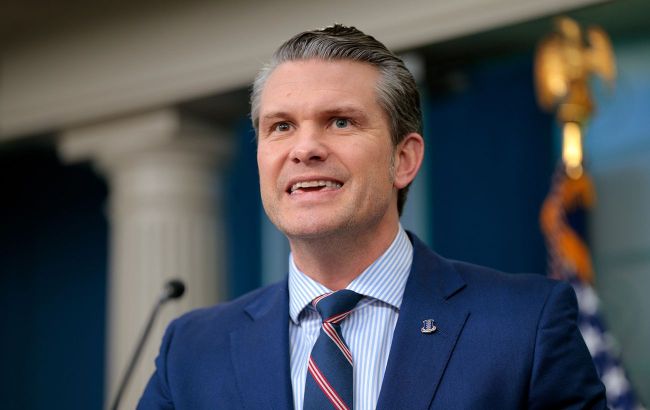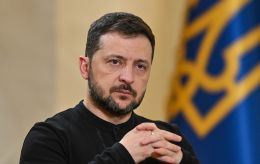US reorients its army, China and Taiwan become main priority
 US Secretary of Defense Pete Gegset (Photo: Getty Images)
US Secretary of Defense Pete Gegset (Photo: Getty Images)
Taiwan is becoming a key challenge for the US: The Pentagon is altering its military strategy and preparing for a potential conflict with China, while Europe will have to defend itself against Russia, reports The Washington Post.
In mid-March, the Pentagon circulated a classified document signed by US Secretary of Defense Lloyd Austin titled Interim National Defense Strategic Guidance. It outlines the implementation of President Donald Trump's concept for preparing and prevailing in a potential war with China and defending the US from threats in the near abroad, including Greenland and the Panama Canal.
The document notes that, due to staffing and resource limitations, the Department of Defense will take risks in other theaters of war. It also anticipates a policy of pressuring allies in Europe, the Middle East, and East Asia to spend more on defense and take on the primary role in deterring threats from Russia, North Korea, and Iran.
According to the publication, the memo by Secretary of Defense Lloyd Austin highlights a potential Chinese invasion of Taiwan as an exceptional scenario with priority over other threats.
The article reminds that in the 2022 National Defense Strategy under the administration of former US President Joe Biden, the primary focus was on alliances to counter Russian aggression. In contrast, in Austin's concept, NATO is expected to take on a much larger burden in defending European countries from Russia, as the US will not provide troops due to its focus on other regions of the world.
The document notes that a significant increase in Europe's involvement in the defense burden also ensures that NATO will be able to reliably deter or defeat Russian aggression, even if deterrence fails, and the United States is already engaged or forced to hold forces for deterrence of the primary conflict in another region.
Confusing document and a clone of the Heritage Foundation
The memo was submitted to the Congressional National Security Committees, where both Republicans and Democrats described it as confusing. The document calls for a withdrawal from most countries, including the Middle East, while the Trump administration had focused on demonstrating military strength and deterring the Houthi rebels in Yemen, as well as applying pressure on Iran.
“There’s tension between ‘We want American strength and military dominance in the world, and we want to be everywhere, but also nowhere,’” said a congressional aide familiar with the document, according to The Washington Post.
The Washington Post also noted that the memorandum consists of nine pages, with some passages resembling a longer report from the Heritage Foundation for 2024 with nearly identical sections. One of the co-authors of the report is Alexander Velez-Green, who is temporarily serving as the Pentagon's senior political official.
In the report released in August of last year, the Heritage Foundation recommended that the Pentagon define three main priorities: deterring a Chinese invasion of Taiwan, defending the United States, and increasing the burden-sharing among allies and partners, as highlighted in Gheset's memo.
A congressional aide noted that Capitol Hill staffers are confident that the document was influenced by the conservative think tank.
The new Pentagon leadership's strategy for denial defense of Taiwan involves increasing military presence with submarines, bombers, unmanned vessels, and special forces from the Army and Marine Corps and a greater focus on bombs that can destroy fortified and underground targets.
The plan also includes improving the defense of US troop locations in the Indo-Pacific region, creating stockpiles at forward positions, and enhancing logistics.
Taiwan factor
Emphasizing the importance of deterring a Chinese invasion of Taiwan, the document also calls for pressuring Taipei to significantly increase its defense spending. Trump and his allies have criticized Taiwan for not investing enough in its own defense, urging the self-governed democratic island to spend up to 10% of its GDP on military readiness - a proportion far exceeding the defense expenditures of the US and its allies.
The Washington Post reminded that since taking office, Trump has avoided responding to questions about whether the US would allow China to seize the island by force.
Two individuals familiar with official negotiations in Taiwan said that the Taipei government is trying to rebuild relations with the new US administration amid growing doubts about Washington's support, which were heightened after the catastrophic February meeting in the Oval Office with Trump, Vice President JD Vance, and Ukrainian President Volodymyr Zelenskyy.
Last week, Taiwan's President Lai Ching-te announced that, as part of a major overhaul of its military infrastructure, the country would increase its defense spending from approximately 2.5% to over 3% of its GDP to reassure Washington. In response, China deployed fighter jets and placed ships near the island, warning that those who played with fire would get burned.
Furthermore, the document orders military leaders to ensure access to the Panama Canal and take a more decisive role in fighting drug trafficking, protecting borders, and handling deportations, typically managed by the Department of Homeland Security.
The memorandum also includes a call to expand US nuclear forces and national missile defense capabilities through the Iron Dome system to protect against long-range missiles.
Transformations in the US Department of Defense
Defense Secretary Pete Hegset signed a memorandum on reducing the number of civilian personnel at the Pentagon. The plan is to lay off between 5% and 8% of personnel at this level.
Recently, Hegset also ordered the development of a plan to reduce the US defense budget over the next five years.
Meanwhile, in the UK and France, there is a belief in the necessity of US support in deploying troops to Ukraine as part of the so-called Coalition of the Willing.

